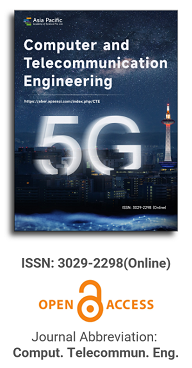
Analyzing device-to-device communication performance with amplify-and-forward relaying amid co-channel interference
Vol 2, Issue 3, 2024
Download PDF
Abstract
Currently, the pressing issue of spectrum limitation, driven by the increasing demand for wireless communication services, has led to the challenge of co-channel interference (CCI) due to the reuse of frequencies in wireless networks. To address this, non-orthogonal multiple access (NOMA) has emerged as a solution. This report conducts a thorough evaluation of NOMA’s system performance over independent and non-identical Rayleigh fading channels in device-to-device (D2D) communications networks, where CCI is significant. The analysis includes examining the probability density function (PDF) and cumulative distribution function (CDF) of the upper SINR threshold. Communication channels are defined as independent and non-identical Rayleigh fading channels, and probability expressions are formulated to assess system failure likelihood for two users. Additionally, Monte-Carlo simulations are conducted to validate the proposed theoretical mathematical expressions.
Keywords
References
- Andreev S, Pyattaev A, Johnsson K, et al. Cellular traffic offloading onto network-assisted device-to-device connections. IEEE Communications Magazine. 2014; 52(4): 20–31. doi: 10.1109/MCOM.2014.6807943
- Wei L, Hu RQ, Qian Y, Wu G. Enable device-to-device communications underlaying cellular networks: Challenges and research aspects. IEEE Communications Magazine. 2014; 52(6): 90–96. doi: 10.1109/MCOM.2014.6829950
- Erturk MC, Mukherjee S, Ishii H, Arslan H. Distributions of transmit power and SINR in device-to-device networks. IEEE Communications Letters. 2013; 17(2): 273–276. doi: 10.1109/LCOMM.2012.122012.121632
- Lee N, Lin X, Andrews JG, Heath RW. Power control for D2D underlaid cellular networks: Modeling, algorithms, and analysis. IEEE Journal on Selected Areas in Communications. 2014; 33(1): 1–13. doi: 10.1109/JSAC.2014.2369612
- Gismalla MS, Azmi AI, Salim MR, et al. Survey on device to device (D2D) communication for 5GB/6G networks: Concept, applications, challenges, and future directions. IEEE Access. 2022; 10: 30792–30821. doi: 10.1109/ACCESS.2022.3160215
- Radaydeh RM. On the bandwidth efficiency of D2D link adaptation under co-channel interference. In: Proceedings of the 2021 IEEE 12th Annual Information Technology, Electronics and Mobile Communication Conference (IEMCON); 27–30 October 2021; Vancouver, BC, Canada. pp. 976–981. doi: 10.1109/IEMCON53756.2021.9623109
- Radaydeh RM. On the performance of imperfect simultaneous D2D association under co-channel interference. In: Proceedings of the 2022 IEEE Wireless Communications and Networking Conference (WCNC); 10–13 April 2022; Austin, TX, USA. pp. 2005–2010. doi: 10.1109/WCNC51071.2022.9771692
- Pei X, Duan W, Wen M, et al. Socially aware joint resource allocation and computation offloading in NOMA-aided energy-harvesting massive IoT. IEEE Internet of Things Journal. 2020; 8(7): 5240–5249. doi: 10.1109/JIOT.2020.3034380
- Tan F, Wu P, Wu YC, Xia M. Energy-efficient non-orthogonal multicast and unicast transmission of cell-free massive MIMO systems with SWIPT. IEEE Journal on Selected Areas in Communications. 2020; 39(4): 949–968. doi: 10.1109/JSAC.2020.3020110
- Papoulis A, Pillai SU. Random Variables and Stochastic Processes, 4th ed. McGraw-Hill Europe; 2002. 852p.
- Aalo VA, Zhang J. Performance analysis of maximal ratio combining in the presence of multiple equal-power cochannel interferers in a Nakagami fading channel. IEEE Transactions on Vehicular Technology. 2001; 50(2): 497–503. doi: 10.1109/25.923061
Supporting Agencies
Copyright (c) 2024 Huu Quy Tran
License URL: https://creativecommons.org/licenses/by/4.0

Prof. Maode Ma
Qatar University, Qatar
The field of computer and telecommunications engineering is rapidly advancing, with the following being some of the latest developments.
more
We are pleased to congratulate the first anniversiry of the journal of Computer and Telecommunication Engineering (CTE).
more
Owing to the tireless dedication of the editor-in-chief, editorial board members, and the in-house editorial team, we are proud to announce the successful online launch of the first issue of Computer and Telecommunication Engineering.
Asia Pacific Academy of Science Pte. Ltd. (APACSCI) specializes in international journal publishing. APACSCI adopts the open access publishing model and provides an important communication bridge for academic groups whose interest fields include engineering, technology, medicine, computer, mathematics, agriculture and forestry, and environment.


.jpg)

.jpg)
